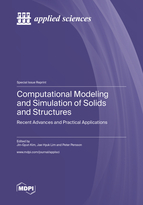Computational Modeling and Simulation of Solids and Structures: Recent Advances and Practical Applications
A special issue of Applied Sciences (ISSN 2076-3417). This special issue belongs to the section "Mechanical Engineering".
Deadline for manuscript submissions: closed (20 February 2022) | Viewed by 41596
Special Issue Editors
Interests: mechanics of composite materials and structures; finite element methods; deployable structures; shock-absorbing structures
Special Issues, Collections and Topics in MDPI journals
Interests: mechanics of composite materials and structures; finite element methods; deployable structures; shock-absorbing structures
Special Issues, Collections and Topics in MDPI journals
Interests: structural dynamics; ground vibration; wave propagation; finite element analysis; stochastic modeling
Special Issues, Collections and Topics in MDPI journals
Special Issue Information
Dear Colleagues,
Computational modeling and simulation are essential to solid and structural mechanics. They have not only covered entire engineering fields (civil, aerospace, mechanical, etc.) but also various scales (from nano to macro) and physics (mono- and multiphysics). Recently, they have been found to be able to offer theoretical backgrounds of digital transformation. Society at large is increasingly enthusiastic about data-driven modeling and simulation, and the possibilities they offer.
The aim of this Special Issue is to provide a forum for researchers to discuss recent advanced computational modeling and simulation techniques of solids and structures, and applications to solve challenging engineering problems. Innovative and novel modeling approaches, numerical methods, and industrial applications are of special interest. The industrial applications should include a strong connection to computational modeling and simulation. We invite contributions to this Special Issue on topics including but not limited to the following:
- Numerical methods:
- Finite elements;
- Flexible multibody dynamics;
- Numerical and semianalytical methods.
- Modeling and simulation aspects:
- Linear/nonlinear dynamics;
- Computational solid mechanics;
- Wave propagation/vibration;
- Multiscale/multiphysics;
- Composites.
- Data-driven modeling and simulation:
- Machine learning based;
- Parameter identification;
- Model updating;
- Stochastic modeling.
- Design of solids and structures:
- Optimization methods;
- Engineering solutions;
- Parametric and topology optimization.
- Applications include, but not limited to:
- Aerospace engineering (aircraft, helicopters, missiles, launchers, satellites, etc.);
- Civil engineering (buildings, lightweight structures, bridges, wind turbines, etc.);
- Mechanical engineering (home appliances, manufacturing devices, robotics, vehicles, precision machinery, etc.)
Prof. Dr. Jin-Gyun Kim
Prof. Dr. Jae Hyuk Lim
Prof. Dr. Peter Persson
Guest Editors
Manuscript Submission Information
Manuscripts should be submitted online at www.mdpi.com by registering and logging in to this website. Once you are registered, click here to go to the submission form. Manuscripts can be submitted until the deadline. All submissions that pass pre-check are peer-reviewed. Accepted papers will be published continuously in the journal (as soon as accepted) and will be listed together on the special issue website. Research articles, review articles as well as short communications are invited. For planned papers, a title and short abstract (about 100 words) can be sent to the Editorial Office for announcement on this website.
Submitted manuscripts should not have been published previously, nor be under consideration for publication elsewhere (except conference proceedings papers). All manuscripts are thoroughly refereed through a single-blind peer-review process. A guide for authors and other relevant information for submission of manuscripts is available on the Instructions for Authors page. Applied Sciences is an international peer-reviewed open access semimonthly journal published by MDPI.
Please visit the Instructions for Authors page before submitting a manuscript. The Article Processing Charge (APC) for publication in this open access journal is 2400 CHF (Swiss Francs). Submitted papers should be well formatted and use good English. Authors may use MDPI's English editing service prior to publication or during author revisions.
Keywords
- computational dynamics
- computational mechanics
- finite element analysis
- wave propagation
- data-driven modeling and simulation
Benefits of Publishing in a Special Issue
- Ease of navigation: Grouping papers by topic helps scholars navigate broad scope journals more efficiently.
- Greater discoverability: Special Issues support the reach and impact of scientific research. Articles in Special Issues are more discoverable and cited more frequently.
- Expansion of research network: Special Issues facilitate connections among authors, fostering scientific collaborations.
- External promotion: Articles in Special Issues are often promoted through the journal's social media, increasing their visibility.
- Reprint: MDPI Books provides the opportunity to republish successful Special Issues in book format, both online and in print.
Further information on MDPI's Special Issue policies can be found here.








